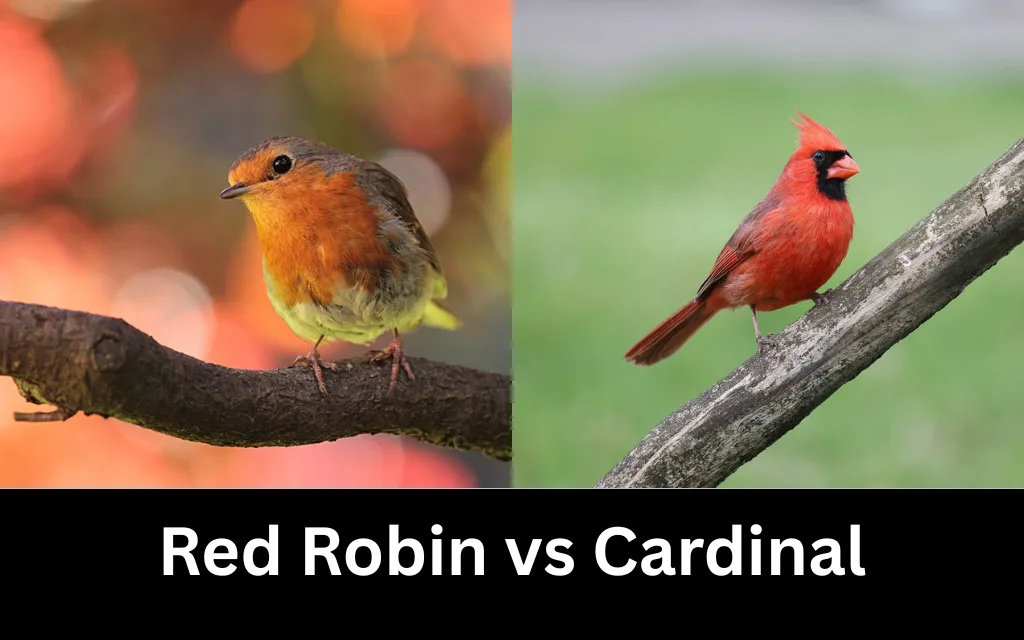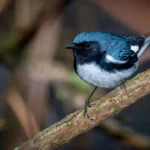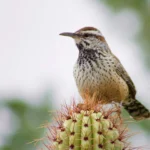Red Robins and Northern Cardinals are two of the most iconic backyard birds in North America. With their bold colors, beautiful songs, and frequent visits to gardens and feeders, they often capture the attention of bird lovers and casual observers alike. But despite some surface-level similarities, these birds have many differences in size, behavior, and habitat.
In this guide, we’ll compare Red Robins vs Cardinals across all major aspects: appearance, vocalizations, behavior, habitat, diet, and more. Whether you’re trying to identify a visitor at your feeder or simply want to learn more about these songbirds, this side-by-side breakdown will help you tell them apart with ease.
Red Robin vs Cardinal
Physical Appearance and Size Comparison
Size and Body Structure
American Robins are slightly larger than cardinals. They have a more elongated body, long legs, and a relatively long tail. Adults typically measure 9 to 11 inches in length, with a wingspan of 12 to 16 inches, and weigh around 2.7 to 3 ounces.
Northern Cardinals, on the other hand, are more compact. They average 8.3 to 9.1 inches long, with a wingspan of 9.8 to 12.2 inches, and weigh only 1.5 to 1.7 ounces. Cardinals often appear more “hunched” when perched, with a thicker bill and a prominent crest on their heads.
Also read: Bird Species That Look Like American Robins
Plumage and Color Patterns
Male Cardinals are bright red all over, with a black mask around the face and a thick red-orange beak. Female Cardinals are a soft tan or brown with red accents on their wings, tail, and crest.
American Robins have a grayish-brown back, vivid orange breast, and black head (more prominent in males). In flight, you may notice a white patch under their tails. Females are duller in tone with a more uniform color contrast.
Also read: 14 Shorebirds of Florida and How to Identify Them
Quick Visual ID Tips
- Look for a red crest and black face mask? It’s a male cardinal.
- Spotting an orange breast with gray back and black head? That’s a robin.
- If the bird looks pale brown with warm red hints and a thick beak, it’s likely a female cardinal.
- No crest and sleek posture usually point to a robin.
Vocalizations and Birdsong Differences
One of the easiest ways to tell a Red Robin from a Northern Cardinal—especially early in the morning—is by their songs. While both species are known for their musical calls, their styles and purposes are different.
Robin Songs and Calls
Robins produce a series of clear, whistling notes that sound cheerful and flowing. Their call is often described as:
“cheerily, cheer-up, cheer-up, cheerily”
They sing most often at dawn and dusk, especially during breeding season. Robins use their songs for both territory defense and attracting mates, and their vocalisations can last for extended periods.
You might also hear sharp “tut-tut” alarm calls or a soft “whinny” when they’re startled or alerting others of predators.
Cardinal Songs and Sounds
Cardinals have a slower, more deliberate song. Their tunes are often melodic whistles that sound like:
“purdy purdy purdy” or “cheer cheer cheer”
Both males and females sing (which is rare among songbirds), and they’re most vocal in spring and summer. Cardinals use their calls mostly for mate communication and territory protection.
Their call notes include a metallic “chip”, often repeated when near feeders or sensing danger.
How to Tell Them Apart by Sound
- Robins: Faster-paced, cheerful and fluid series of whistles
- Cardinals: Slower, more rhythmic, often rising and falling in pitch
- Robins sing longer, while Cardinals sing shorter, more repetitive songs
- Alarm calls differ: Robins give high-pitched tutting, Cardinals give sharp chips
Habitat and Geographic Range
While both Red Robins and Northern Cardinals are common across much of the United States, their preferred environments and year-round behaviors differ.
American Robin Habitat
Robins are incredibly versatile and adapt well to a variety of environments. You’ll find them in:
- Suburban lawns and gardens
- Parks and schoolyards
- Golf courses and pastures
- Woodlands and forest edges
- Open tundra in the north during migration
Robins are migratory. In northern states, they typically appear in early spring and migrate southward in winter. In southern states like Texas or Florida, you might see them all year long.
They prefer areas with short grass and soft soil, where it’s easier to hunt for worms and insects.
Northern Cardinal Habitat
Cardinals are non-migratory and stay in one area year-round. They thrive in:
- Shrubby woodlands and forest edges
- Backyard gardens with thick vegetation
- Suburban neighborhoods with bird feeders
- Brushy fields and overgrown hedgerows
Cardinals are shy and prefer dense cover, often staying hidden in foliage. Unlike robins, they are less likely to be seen foraging in open lawns unless food sources are nearby.
Range Map Notes
- Robins: Found across the entire U.S. and Canada, expanding north in summer and retreating south in winter
- Cardinals: Found throughout the eastern and southern U.S., particularly abundant in the Southeast and Midwest, slowly expanding northward
Diet and Feeding Habits
While both robins and cardinals are common backyard birds, they have distinct diets and foraging styles that can help you tell them apart.
What Robins Eat
Robins are omnivores, with a diet that changes depending on the season. In spring and summer, they are most often seen hopping across lawns, searching for:
- Earthworms (a favorite!)
- Beetles, caterpillars, and other insects
- Spiders and small snails
In fall and winter, when insects are scarce, robins shift to eating more berries and fruits, including:
- Juniper berries
- Crabapples
- Elderberries
- Mulberries
They forage mainly on the ground, tugging worms from the soil or grabbing fallen fruit.
What Cardinals Eat
Cardinals are primarily granivores, meaning they eat a lot of seeds. Their strong, cone-shaped bills are perfect for cracking:
- Sunflower seeds
- Safflower seeds
- Millet
- Cracked corn
They also enjoy:
- Berries and small fruits
- Insects (especially during breeding season to feed chicks)
Cardinals are frequent visitors at bird feeders, especially in winter. They prefer platform or tray feeders and often wait patiently nearby before feeding.
Key Feeding Differences
| Feature | Robin | Cardinal |
|---|---|---|
| Diet Type | Omnivore (insects + fruit) | Granivore (seeds + fruit) |
| Foraging Style | Ground forager | Bushes, shrubs, and feeders |
| Favorite Foods | Worms, berries | Sunflower seeds, berries |
| Visits Feeders? | Rarely | Frequently |
Breeding and Nesting Behaviors
When it comes to courtship, nest-building, and raising young, robins and cardinals have very different approaches. These differences can offer helpful clues when identifying which bird is nesting in your backyard.
Robin Nesting Habits
American Robins are seasonal breeders, usually raising two to three broods per year during spring and summer. Their nesting behavior includes:
- Nest Construction: Built almost exclusively by the female, using twigs, grass, and mud to form a sturdy, cup-shaped structure.
- Nest Location: Often found in trees, shrubs, ledges, eaves, lamp posts—even porch lights!
- Eggs: 3–5 light blue eggs per clutch.
- Parental Roles: Females incubate the eggs; males help guard the area and feed the young after hatching.
Robins typically raise multiple broods in a single season, sometimes building a new nest for each one.
Cardinal Nesting Habits
Northern Cardinals are known for their monogamous relationships. Pairs often stay together for several seasons or even for life.
- Nest Construction: The female builds the nest, but the male assists by bringing materials like twigs and leaves.
- Nest Location: Hidden in dense shrubs or low trees, usually 3 to 10 feet above the ground.
- Eggs: 2–5 pale eggs with dark speckling.
- Parental Roles: Both parents feed the chicks. Males are often seen feeding females during incubation—part of their strong pair bonding.
Cardinals are protective of their nesting area and often choose hidden locations to keep predators away.
Social Behavior and Territorial Traits
While both robins and cardinals are commonly seen around humans, their social and territorial behaviors differ quite a bit—especially during the breeding season.
Robin Behavior
Robins are known to be territorial during nesting but become more social during the colder months.
- Breeding Season: Males aggressively defend nesting territory with sharp, whistling calls and physical displays.
- Winter Months: Robins gather in large flocks, sometimes numbering in the hundreds, especially when roosting in berry-laden trees.
- Foraging: They often hop confidently across lawns in search of food, showing little fear of humans.
This shift from territorial to social behavior makes robins quite dynamic throughout the year.
Cardinal Behavior
Cardinals are more solitary by nature and usually stick to pairs or small family groups.
- Breeding Season: Males are highly territorial, frequently chasing away other cardinals and giving sharp metallic “chip” calls to warn intruders.
- Year-Round Behavior: Even outside of breeding, cardinals often forage alone or in pairs rather than joining flocks.
- Shyness: Cardinals are more cautious around people, often staying hidden in foliage and approaching feeders only when they feel secure.
Behavior at a Glance
| Trait | Robins | Cardinals |
|---|---|---|
| Territorial? | Yes, during breeding | Yes, especially males year-round |
| Social Behavior | Flock in winter | Mostly solitary or in pairs |
| Interaction with Humans | Bold, frequent lawn foragers | Cautious, prefer shrub cover |
Flight Style and Movement Patterns
Though both robins and cardinals are strong flyers, they differ noticeably in how they move through the air—and understanding these patterns can help with quick identification.
Robin Flight Characteristics
Robins have a direct and purposeful flight style. When they take off, it often looks like they’re heading somewhere with intent.
- Flight Pattern: Strong, straight-line flights with steady wingbeats
- Takeoff Style: Quick and fluid, often from open areas or perches
- In the Air: Wings twist slightly rather than flapping straight up and down
This efficient flight style is ideal for longer migrations and quick bursts across open spaces.
Cardinal Flight Characteristics
Cardinals have a more fluttery and undulating flight, with noticeable dips and rises. Their movement often appears a bit clumsy but is ideal for navigating thick vegetation.
- Flight Pattern: Short bursts of rapid wingbeats followed by glides
- Takeoff Style: Hops and flutters upward from shrubs or low branches
- In the Air: Often appears erratic, with sharp turns and curves
Their less aerodynamic style reflects their tendency to stay close to the ground and near dense cover.
Flight Comparison Summary
| Flight Trait | Robins | Cardinals |
|---|---|---|
| Style | Direct, straight, purposeful | Fluttery, erratic, with dips and glides |
| Best Seen | In open areas like lawns or fields | In bushy areas, backyard feeders |
| Takeoff Behavior | Confident launch from ground/perch | Quick, upward flutter from low cover |
Field Identification and Quick Tips
Spotting a robin or a cardinal in the wild can be exciting, but if you’re unsure which bird you’re looking at, these quick field ID tips can help you confidently tell them apart.
Quick Visual Cues
| Feature | American Robin | Northern Cardinal |
|---|---|---|
| Overall Color | Grayish-brown back, orange chest | Male: Bright red, Female: Tan with red tint |
| Head | Black in males, paler in females | Black “mask” around the beak (both sexes) |
| Bill | Yellow and slender | Thick, cone-shaped, reddish-orange |
| Tail | Long and fan-shaped | Medium and rounded |
| Crest | Absent | Pointed crest on top of head |
Behavior Clues
- Robin:
- Bold, hops across open lawns
- Forms large winter flocks
- Frequently seen pulling worms from soil
- Cardinal:
- Shy, hides in shrubs
- Forages in pairs or alone
- Common at feeders, especially in early morning and dusk
Vocalization Tip
If you hear a cheerful, fluid tune with longer phrases, it’s likely a robin.
If the song is whistled, slow, and melodic, that’s a cardinal.
Symbolism and Human Connection
Both the American Robin and the Northern Cardinal hold special places in American culture, folklore, and spirituality. Their appearances are often tied to meaningful moments, especially for those who enjoy backyard birdwatching.
Robin Symbolism
The robin is often seen as a harbinger of spring—its return north is one of the first signs that winter is ending. Because of this, robins are associated with:
- Renewal and rebirth
- Hope and optimism
- The changing of seasons
In spiritual circles, robins are sometimes believed to represent the presence of deceased loved ones, especially when seen in peaceful moments or unusual settings.
Cardinal Symbolism
Cardinals are especially powerful spiritual symbols in many U.S. households. Their bright red color and frequent appearances near homes have made them symbols of:
- Love and devotion
- Spiritual visitation (especially of loved ones who’ve passed)
- Protection and guidance
The popular saying goes:
“When a cardinal appears, a loved one is near.”
Many people believe cardinals deliver comfort during periods of grief or uncertainty, especially when seen after a personal loss.
Conservation Status and Human Impact
While both robins and cardinals are common sights across the U.S., understanding their conservation status helps us appreciate how they interact with our changing environments—and how we can support their populations.
American Robin
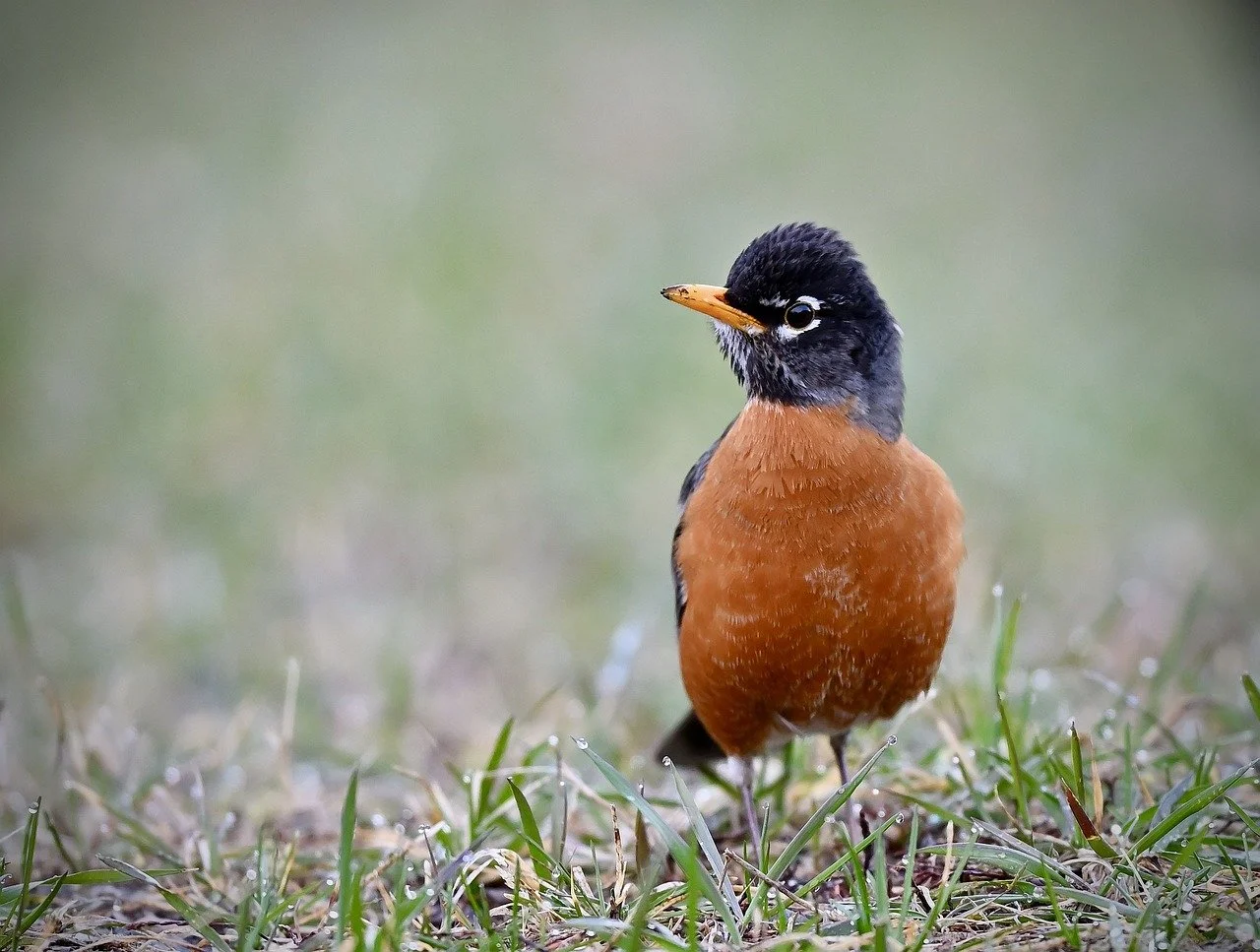
- Conservation Status: Least Concern (IUCN)
- Population Trend: Stable and widespread
- Threats:
- Pesticide use (can contaminate their food supply)
- Habitat loss due to urban development
- Window collisions during flight
Robins are highly adaptable. They thrive in suburban lawns, parks, and gardens, making them one of the most familiar wild birds in America. Their broad diet and nesting flexibility help them survive in a variety of landscapes.
Northern Cardinal
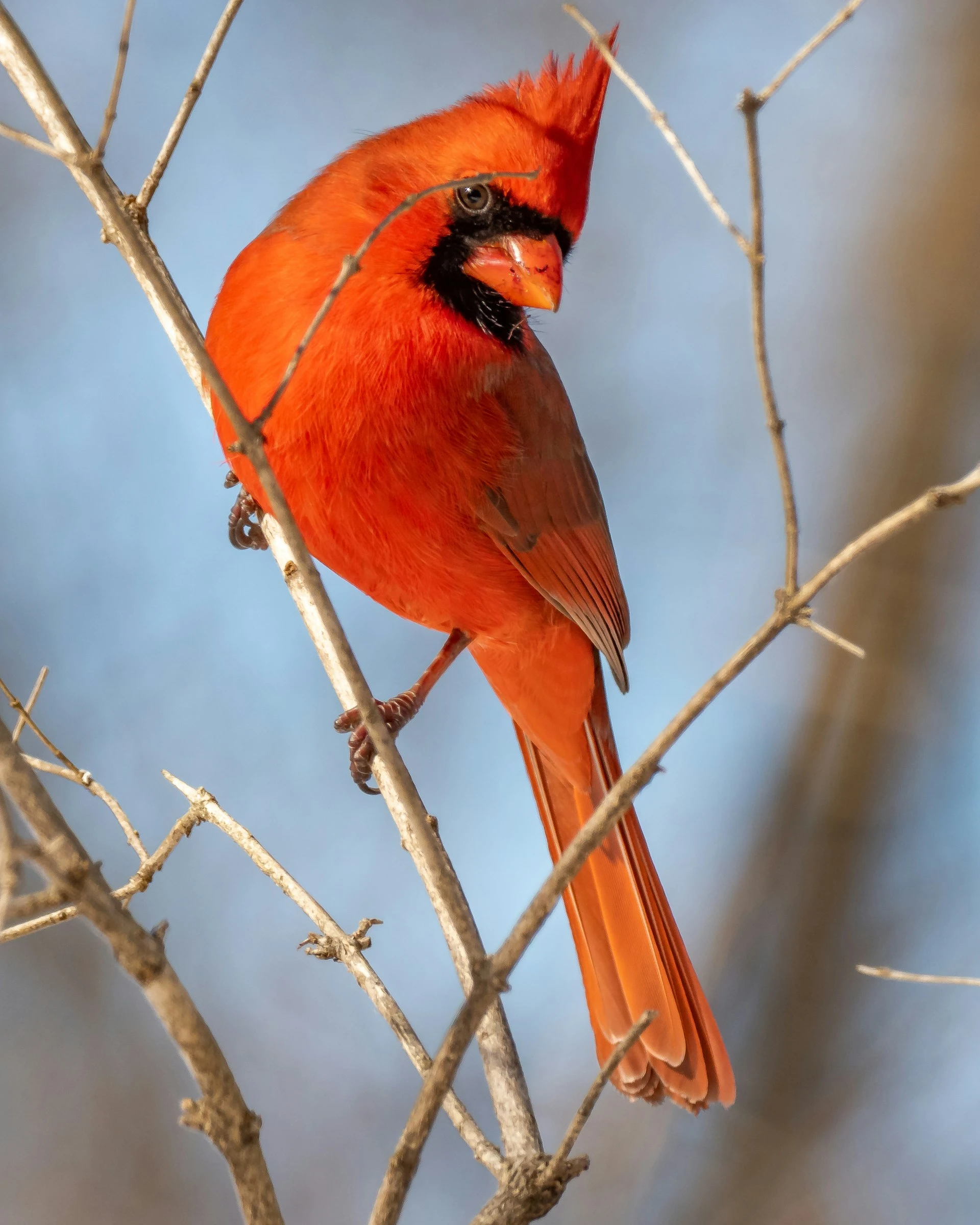
- Conservation Status: Least Concern (IUCN)
- Population Trend: Increasing in parts of the U.S.
- Threats:
- Habitat fragmentation
- Predation of nests (especially by cats or raccoons)
- Glass collisions
Cardinals benefit from bird feeders and backyard landscaping, which provide food and safe places to nest. As more people add feeders and native plants to their yards, cardinals have extended their range northward over the last few decades.
How You Can Help
- Plant native shrubs and trees for natural shelter
- Avoid pesticides and herbicides in gardens
- Add a bird bath or shallow water source
- Place window decals to prevent bird strikes
- Use bird-friendly feeders stocked with seeds like sunflower and safflower
Frequently Asked Questions (FAQs)
Are robins and cardinals related?
No, robins and cardinals are not closely related. The American Robin is a member of the thrush family (Turdidae), while the Northern Cardinal belongs to the cardinal family (Cardinalidae). They may share similar habitats, but they come from different evolutionary branches.
Why do robins and cardinals sound similar?
Their songs can sound similar to untrained ears, especially in early spring. However, robins tend to have cheerier, more continuous songs, while cardinals sing slower, melodic whistles. With a bit of practice, you can learn to tell them apart by tone and rhythm.
Can robins and cardinals nest in the same yard?
Yes! Both birds are common in suburban and rural areas. Robins prefer open spaces and often nest on structures, while cardinals favor dense shrubs and low trees. As long as food and cover are available, it’s not unusual to see both in the same yard.
Do robins and cardinals migrate?
Robins: Partially migratory. Many head south in winter, but some stay in mild climates year-round.
Cardinals: Non-migratory. They remain in their home range all year long, often seen at feeders even in snowy conditions.
Conclusion
Though often confused due to their vibrant plumage and familiar presence, American Robins and Northern Cardinals are remarkably distinct. Robins are larger, migratory, and active foragers often seen on open lawns. Cardinals are smaller, non-migratory, and more likely to stay hidden in shrubs and trees.
From their flight patterns to their nesting habits and even their songs, each bird has unique traits that set it apart. Whether you’re a casual backyard birder or a devoted nature enthusiast, recognising these differences deepens your appreciation for both species.
No matter which bird shows up at your feeder first, both robins and cardinals bring color, music, and wonder to American landscapes year-round.

Welcome to World Birds Life, where the wonder of birds takes center stage. My name is Lexi, and I’m passionate about helping you discover the beauty and joy that birds bring into our lives.

